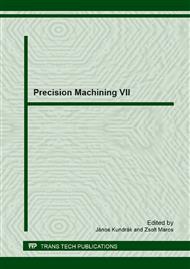[1]
Y. K. Chou, C.J. Evans, M.M. Barash, Experimental Investigation on CBN Turning of Hardened AISI 52100 Steel. J. of Mat. Proc. Technology 124 (2002) pp.274-283.
DOI: 10.1016/s0924-0136(02)00180-2
Google Scholar
[2]
Ty. G. Dawson, T. R. Kurfess, Machining Hardened Steel with Ceramic-coated and Uncoated PCBN Cutting Tools. Transactions of the North American Manufacturing Research Institution of SME, 129 (2002), p.200–208.
Google Scholar
[3]
M. A. Yallese, K. Chaoui, N. Zeghib, L. Boulanouar, J. F. Rigal, Hard Machining of Hardened Bearing Steel Using Cubic Boron Nitride Tool. Journal Materials Processing Technology, 2009, 209, pp.1092-1104.
DOI: 10.1016/j.jmatprotec.2008.03.014
Google Scholar
[4]
A. G. Mamalis, J. Kundrak, M. Horvath, Wear and Tool Life of CBN Cutting Tools International Journal of Advanced Manufacturing Technology Volume: 20 Issue: 7 pp.475-479.
DOI: 10.1007/s001700200180
Google Scholar
[5]
A. G. Mamalis, J. Kundrak, M. Horvath, On a Novel Tool Life Relation for Precision Cutting Tools, Journal of Manufacturing Science and Engineering - Transactions of the ASME 127 (2) pp.328-332 May (2005).
DOI: 10.1115/1.1794158
Google Scholar
[6]
J. Kundrak, Z. Pálmai, Investigation of Machinability in Boring of Inner Cylindrical Surfaces of Hardened Bearing Steels. Proceedings of the 13th International Conference on Tools (ICT 2012) Miskolc, Hungary pp.165-170 ISBN 978-963-9988-35-4.
Google Scholar
[7]
O. Szabó, Stability Criteria and Break out of Grains of Super-Hard of Grinding Tools, Journal of Materials Processing Technology. ELSEVIR, Dublin, 155-156 (2004)., p.2007-(2010).
DOI: 10.1016/j.jmatprotec.2004.04.207
Google Scholar
[8]
R. Čep, A. Janásek, L. Čepová, J. Petrů, I. Hlavatý, Z. Car, M. Hatala, Experimental Testing of Exchangeable Cutting Inserts Cutting Ability. Technical Gazette 20, 1(2013), pp.21-26.
Google Scholar
[9]
M. A. Davies, Y. Chou, C. J. Evans, On Chip Morphology, Tool Wear and Cutting Mechanics in Finish Hard Turning. Annals of the CIRP Vol. 45/1/1996 pp.77-82.
DOI: 10.1016/s0007-8506(07)63020-0
Google Scholar
[10]
Y. Huang, S.Y. Liang, Modelling of CBN Tool Flank Wear Progression in Finish Hard Turning. Transactions of the ASME Vol. 126, February 2004 pp.98-106.
DOI: 10.1115/1.1644543
Google Scholar


